Analysis of Different Storage Media for Data Storage and Archiving
VerifiedAdded on 2023/06/14
|8
|1480
|372
AI Summary
This report analyzes the use of different storage media and categorizes them according to their usability for data storage and archiving. The five types of storage media discussed are Solid State Drive, Hard Disk Drive, Online Storage, Optical Storage Devices, and Tape. The report categorizes these devices based on their performance, price, usability, and data archiving capabilities.
Contribute Materials
Your contribution can guide someone’s learning journey. Share your
documents today.
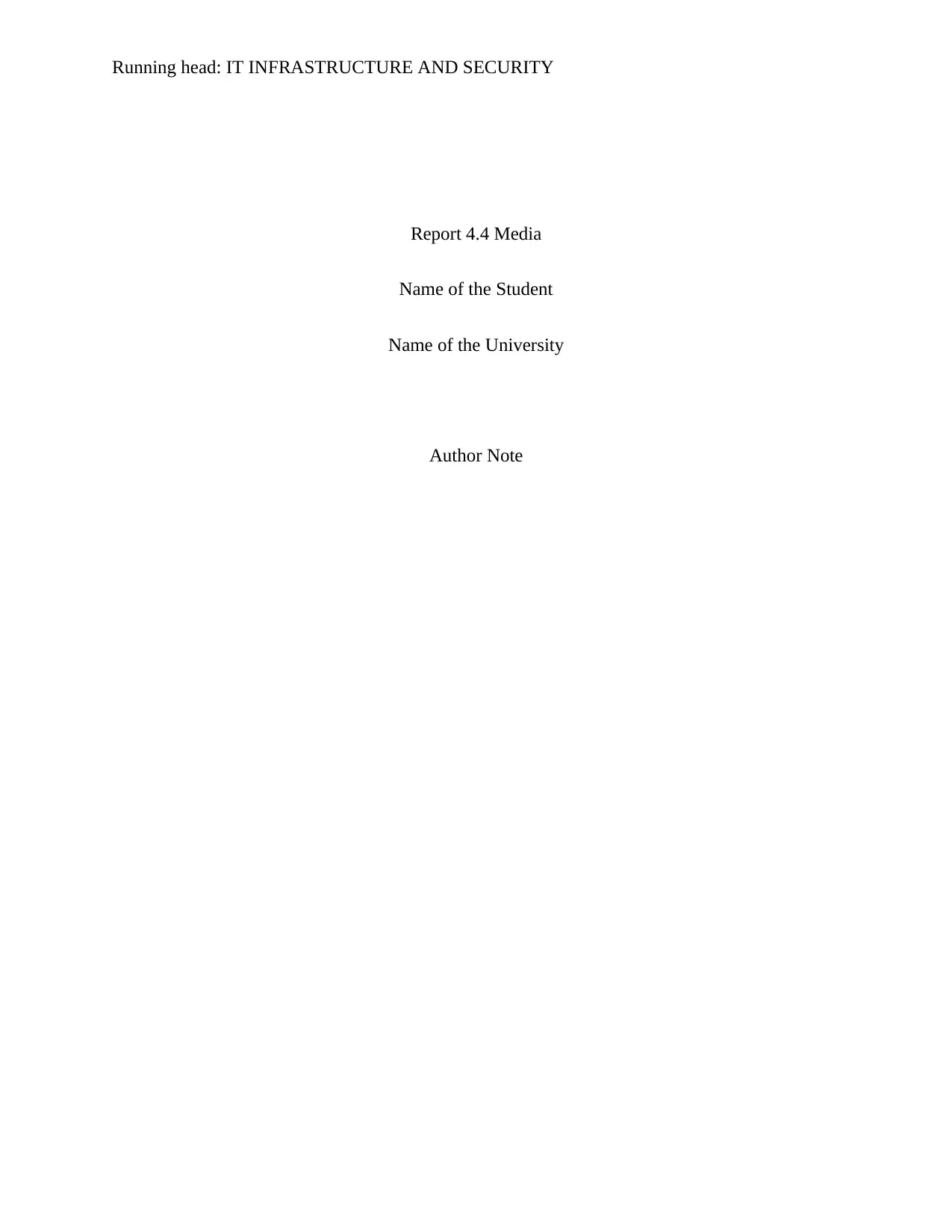
Running head: IT INFRASTRUCTURE AND SECURITY
Report 4.4 Media
Name of the Student
Name of the University
Author Note
Report 4.4 Media
Name of the Student
Name of the University
Author Note
Secure Best Marks with AI Grader
Need help grading? Try our AI Grader for instant feedback on your assignments.

1IT INFRASTRUCTURE AND SECURITY
Abstract
The purpose of this assignment is to analyze the use of different storage media and categorize
them according to their usability.
Abstract
The purpose of this assignment is to analyze the use of different storage media and categorize
them according to their usability.
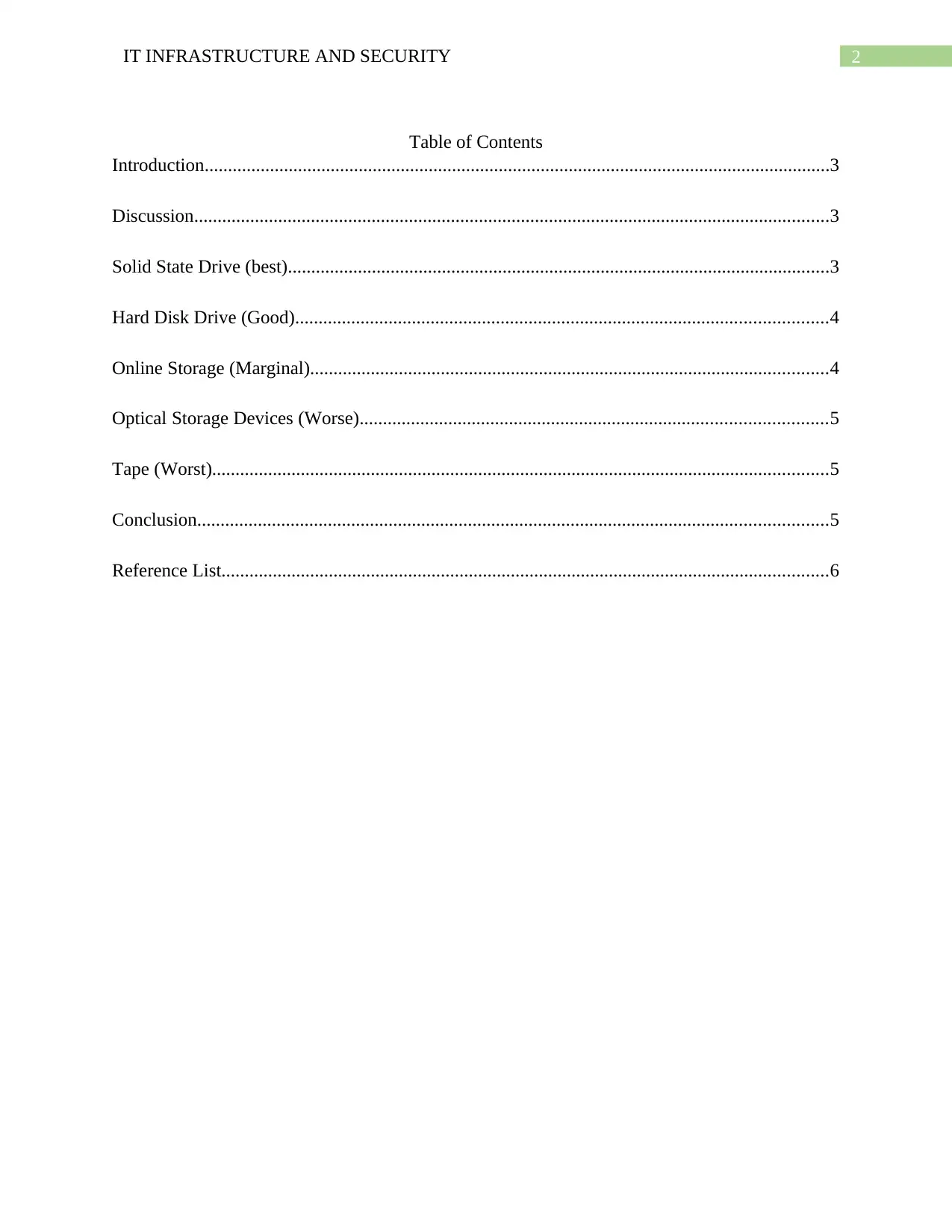
2IT INFRASTRUCTURE AND SECURITY
Table of Contents
Introduction......................................................................................................................................3
Discussion........................................................................................................................................3
Solid State Drive (best)....................................................................................................................3
Hard Disk Drive (Good)..................................................................................................................4
Online Storage (Marginal)...............................................................................................................4
Optical Storage Devices (Worse)....................................................................................................5
Tape (Worst)....................................................................................................................................5
Conclusion.......................................................................................................................................5
Reference List..................................................................................................................................6
Table of Contents
Introduction......................................................................................................................................3
Discussion........................................................................................................................................3
Solid State Drive (best)....................................................................................................................3
Hard Disk Drive (Good)..................................................................................................................4
Online Storage (Marginal)...............................................................................................................4
Optical Storage Devices (Worse)....................................................................................................5
Tape (Worst)....................................................................................................................................5
Conclusion.......................................................................................................................................5
Reference List..................................................................................................................................6
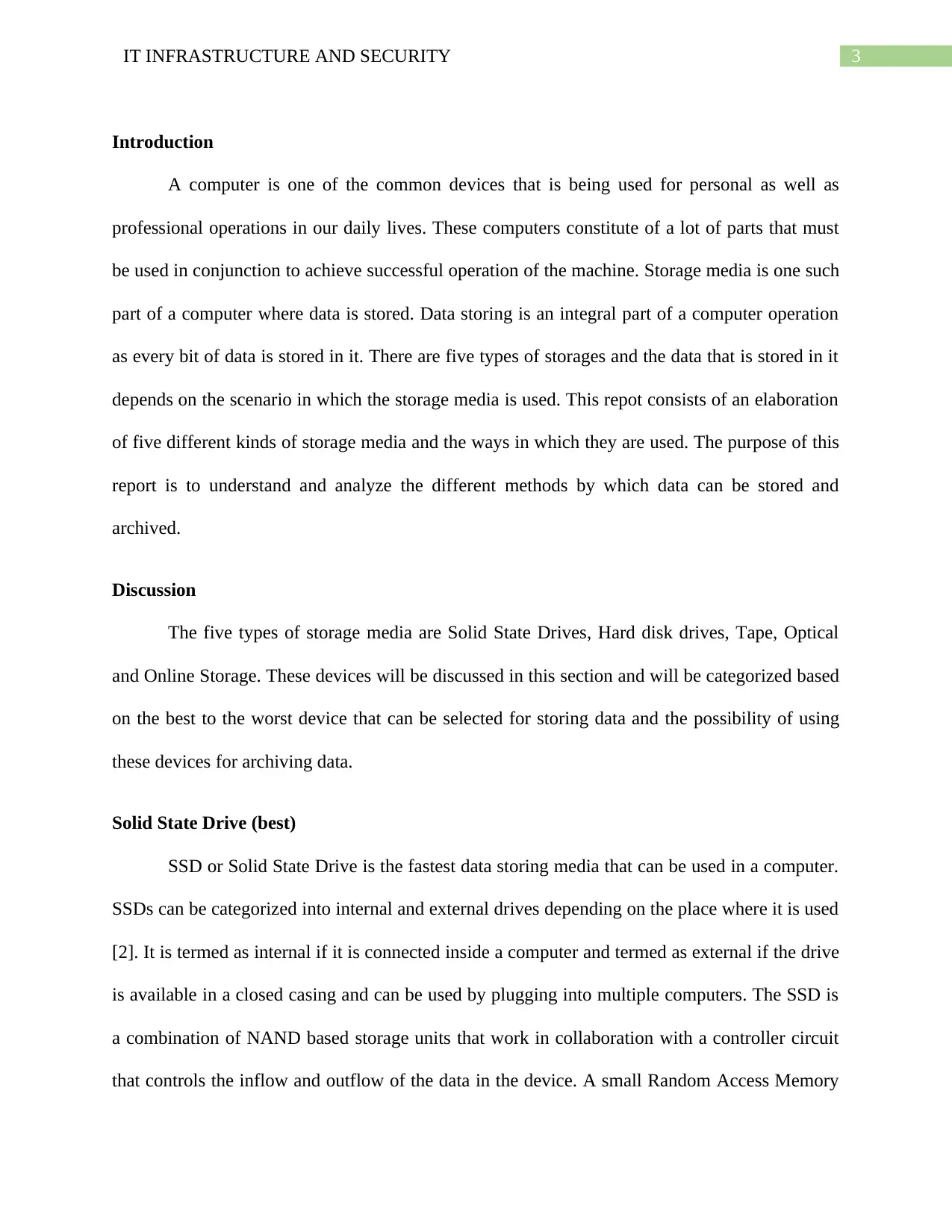
3IT INFRASTRUCTURE AND SECURITY
Introduction
A computer is one of the common devices that is being used for personal as well as
professional operations in our daily lives. These computers constitute of a lot of parts that must
be used in conjunction to achieve successful operation of the machine. Storage media is one such
part of a computer where data is stored. Data storing is an integral part of a computer operation
as every bit of data is stored in it. There are five types of storages and the data that is stored in it
depends on the scenario in which the storage media is used. This repot consists of an elaboration
of five different kinds of storage media and the ways in which they are used. The purpose of this
report is to understand and analyze the different methods by which data can be stored and
archived.
Discussion
The five types of storage media are Solid State Drives, Hard disk drives, Tape, Optical
and Online Storage. These devices will be discussed in this section and will be categorized based
on the best to the worst device that can be selected for storing data and the possibility of using
these devices for archiving data.
Solid State Drive (best)
SSD or Solid State Drive is the fastest data storing media that can be used in a computer.
SSDs can be categorized into internal and external drives depending on the place where it is used
[2]. It is termed as internal if it is connected inside a computer and termed as external if the drive
is available in a closed casing and can be used by plugging into multiple computers. The SSD is
a combination of NAND based storage units that work in collaboration with a controller circuit
that controls the inflow and outflow of the data in the device. A small Random Access Memory
Introduction
A computer is one of the common devices that is being used for personal as well as
professional operations in our daily lives. These computers constitute of a lot of parts that must
be used in conjunction to achieve successful operation of the machine. Storage media is one such
part of a computer where data is stored. Data storing is an integral part of a computer operation
as every bit of data is stored in it. There are five types of storages and the data that is stored in it
depends on the scenario in which the storage media is used. This repot consists of an elaboration
of five different kinds of storage media and the ways in which they are used. The purpose of this
report is to understand and analyze the different methods by which data can be stored and
archived.
Discussion
The five types of storage media are Solid State Drives, Hard disk drives, Tape, Optical
and Online Storage. These devices will be discussed in this section and will be categorized based
on the best to the worst device that can be selected for storing data and the possibility of using
these devices for archiving data.
Solid State Drive (best)
SSD or Solid State Drive is the fastest data storing media that can be used in a computer.
SSDs can be categorized into internal and external drives depending on the place where it is used
[2]. It is termed as internal if it is connected inside a computer and termed as external if the drive
is available in a closed casing and can be used by plugging into multiple computers. The SSD is
a combination of NAND based storage units that work in collaboration with a controller circuit
that controls the inflow and outflow of the data in the device. A small Random Access Memory
Secure Best Marks with AI Grader
Need help grading? Try our AI Grader for instant feedback on your assignments.
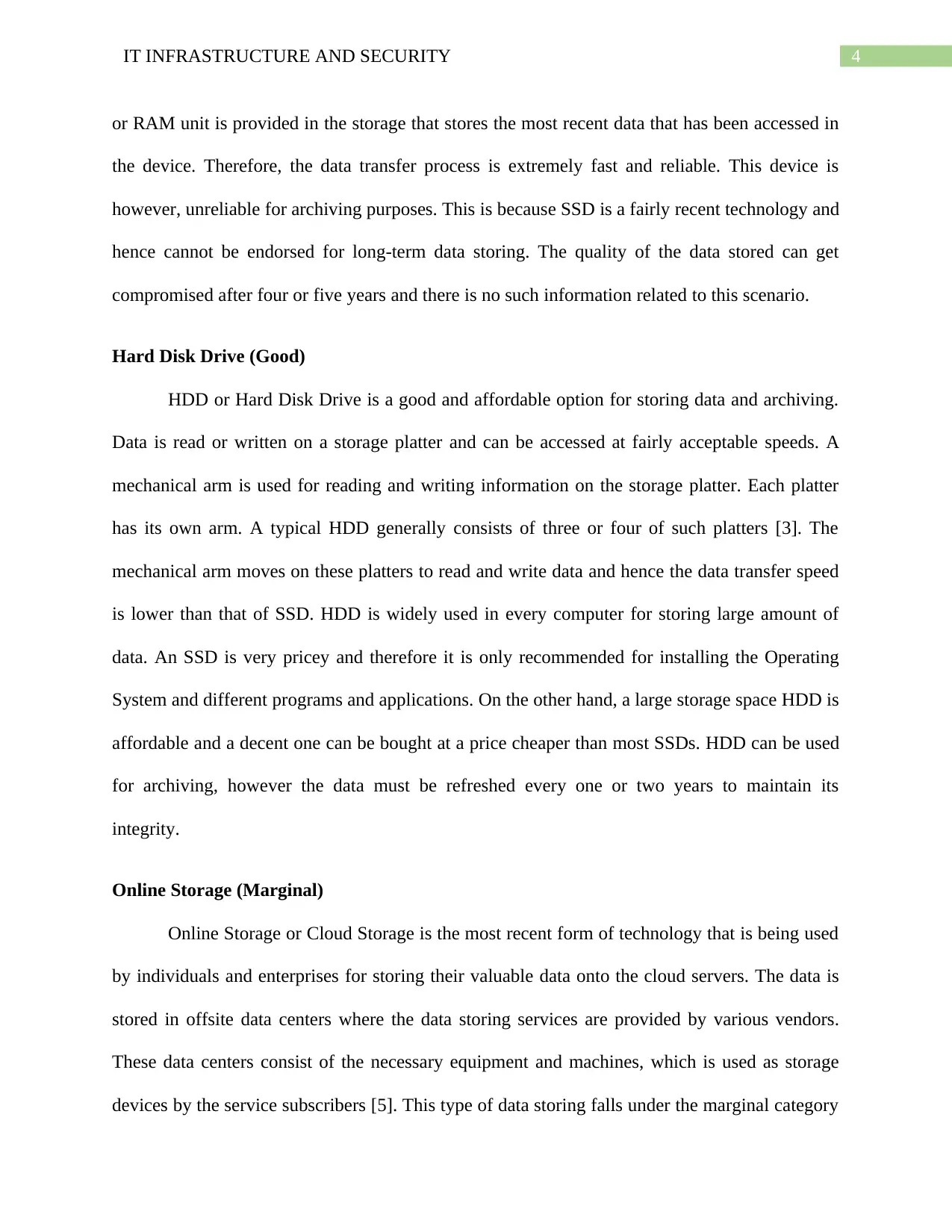
4IT INFRASTRUCTURE AND SECURITY
or RAM unit is provided in the storage that stores the most recent data that has been accessed in
the device. Therefore, the data transfer process is extremely fast and reliable. This device is
however, unreliable for archiving purposes. This is because SSD is a fairly recent technology and
hence cannot be endorsed for long-term data storing. The quality of the data stored can get
compromised after four or five years and there is no such information related to this scenario.
Hard Disk Drive (Good)
HDD or Hard Disk Drive is a good and affordable option for storing data and archiving.
Data is read or written on a storage platter and can be accessed at fairly acceptable speeds. A
mechanical arm is used for reading and writing information on the storage platter. Each platter
has its own arm. A typical HDD generally consists of three or four of such platters [3]. The
mechanical arm moves on these platters to read and write data and hence the data transfer speed
is lower than that of SSD. HDD is widely used in every computer for storing large amount of
data. An SSD is very pricey and therefore it is only recommended for installing the Operating
System and different programs and applications. On the other hand, a large storage space HDD is
affordable and a decent one can be bought at a price cheaper than most SSDs. HDD can be used
for archiving, however the data must be refreshed every one or two years to maintain its
integrity.
Online Storage (Marginal)
Online Storage or Cloud Storage is the most recent form of technology that is being used
by individuals and enterprises for storing their valuable data onto the cloud servers. The data is
stored in offsite data centers where the data storing services are provided by various vendors.
These data centers consist of the necessary equipment and machines, which is used as storage
devices by the service subscribers [5]. This type of data storing falls under the marginal category
or RAM unit is provided in the storage that stores the most recent data that has been accessed in
the device. Therefore, the data transfer process is extremely fast and reliable. This device is
however, unreliable for archiving purposes. This is because SSD is a fairly recent technology and
hence cannot be endorsed for long-term data storing. The quality of the data stored can get
compromised after four or five years and there is no such information related to this scenario.
Hard Disk Drive (Good)
HDD or Hard Disk Drive is a good and affordable option for storing data and archiving.
Data is read or written on a storage platter and can be accessed at fairly acceptable speeds. A
mechanical arm is used for reading and writing information on the storage platter. Each platter
has its own arm. A typical HDD generally consists of three or four of such platters [3]. The
mechanical arm moves on these platters to read and write data and hence the data transfer speed
is lower than that of SSD. HDD is widely used in every computer for storing large amount of
data. An SSD is very pricey and therefore it is only recommended for installing the Operating
System and different programs and applications. On the other hand, a large storage space HDD is
affordable and a decent one can be bought at a price cheaper than most SSDs. HDD can be used
for archiving, however the data must be refreshed every one or two years to maintain its
integrity.
Online Storage (Marginal)
Online Storage or Cloud Storage is the most recent form of technology that is being used
by individuals and enterprises for storing their valuable data onto the cloud servers. The data is
stored in offsite data centers where the data storing services are provided by various vendors.
These data centers consist of the necessary equipment and machines, which is used as storage
devices by the service subscribers [5]. This type of data storing falls under the marginal category
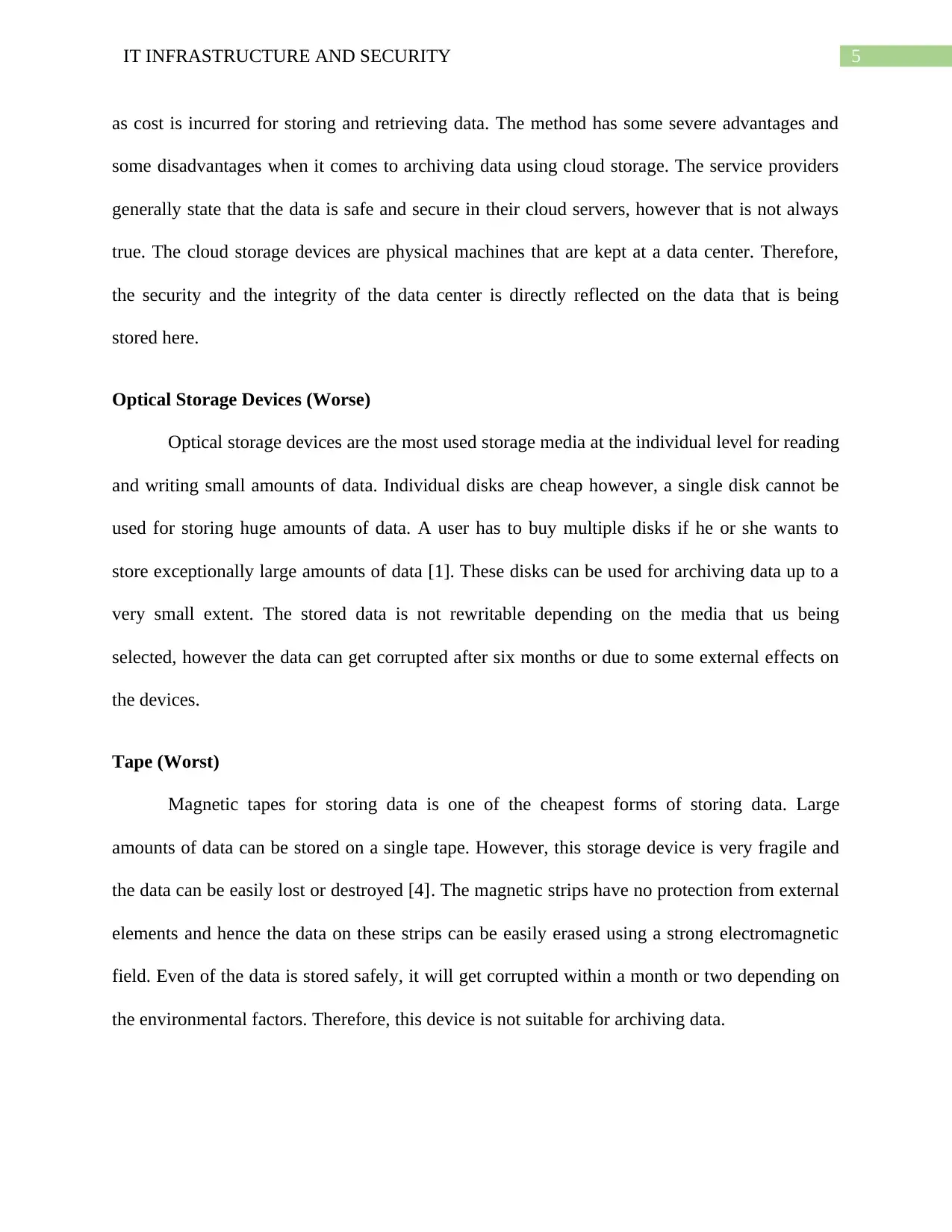
5IT INFRASTRUCTURE AND SECURITY
as cost is incurred for storing and retrieving data. The method has some severe advantages and
some disadvantages when it comes to archiving data using cloud storage. The service providers
generally state that the data is safe and secure in their cloud servers, however that is not always
true. The cloud storage devices are physical machines that are kept at a data center. Therefore,
the security and the integrity of the data center is directly reflected on the data that is being
stored here.
Optical Storage Devices (Worse)
Optical storage devices are the most used storage media at the individual level for reading
and writing small amounts of data. Individual disks are cheap however, a single disk cannot be
used for storing huge amounts of data. A user has to buy multiple disks if he or she wants to
store exceptionally large amounts of data [1]. These disks can be used for archiving data up to a
very small extent. The stored data is not rewritable depending on the media that us being
selected, however the data can get corrupted after six months or due to some external effects on
the devices.
Tape (Worst)
Magnetic tapes for storing data is one of the cheapest forms of storing data. Large
amounts of data can be stored on a single tape. However, this storage device is very fragile and
the data can be easily lost or destroyed [4]. The magnetic strips have no protection from external
elements and hence the data on these strips can be easily erased using a strong electromagnetic
field. Even of the data is stored safely, it will get corrupted within a month or two depending on
the environmental factors. Therefore, this device is not suitable for archiving data.
as cost is incurred for storing and retrieving data. The method has some severe advantages and
some disadvantages when it comes to archiving data using cloud storage. The service providers
generally state that the data is safe and secure in their cloud servers, however that is not always
true. The cloud storage devices are physical machines that are kept at a data center. Therefore,
the security and the integrity of the data center is directly reflected on the data that is being
stored here.
Optical Storage Devices (Worse)
Optical storage devices are the most used storage media at the individual level for reading
and writing small amounts of data. Individual disks are cheap however, a single disk cannot be
used for storing huge amounts of data. A user has to buy multiple disks if he or she wants to
store exceptionally large amounts of data [1]. These disks can be used for archiving data up to a
very small extent. The stored data is not rewritable depending on the media that us being
selected, however the data can get corrupted after six months or due to some external effects on
the devices.
Tape (Worst)
Magnetic tapes for storing data is one of the cheapest forms of storing data. Large
amounts of data can be stored on a single tape. However, this storage device is very fragile and
the data can be easily lost or destroyed [4]. The magnetic strips have no protection from external
elements and hence the data on these strips can be easily erased using a strong electromagnetic
field. Even of the data is stored safely, it will get corrupted within a month or two depending on
the environmental factors. Therefore, this device is not suitable for archiving data.
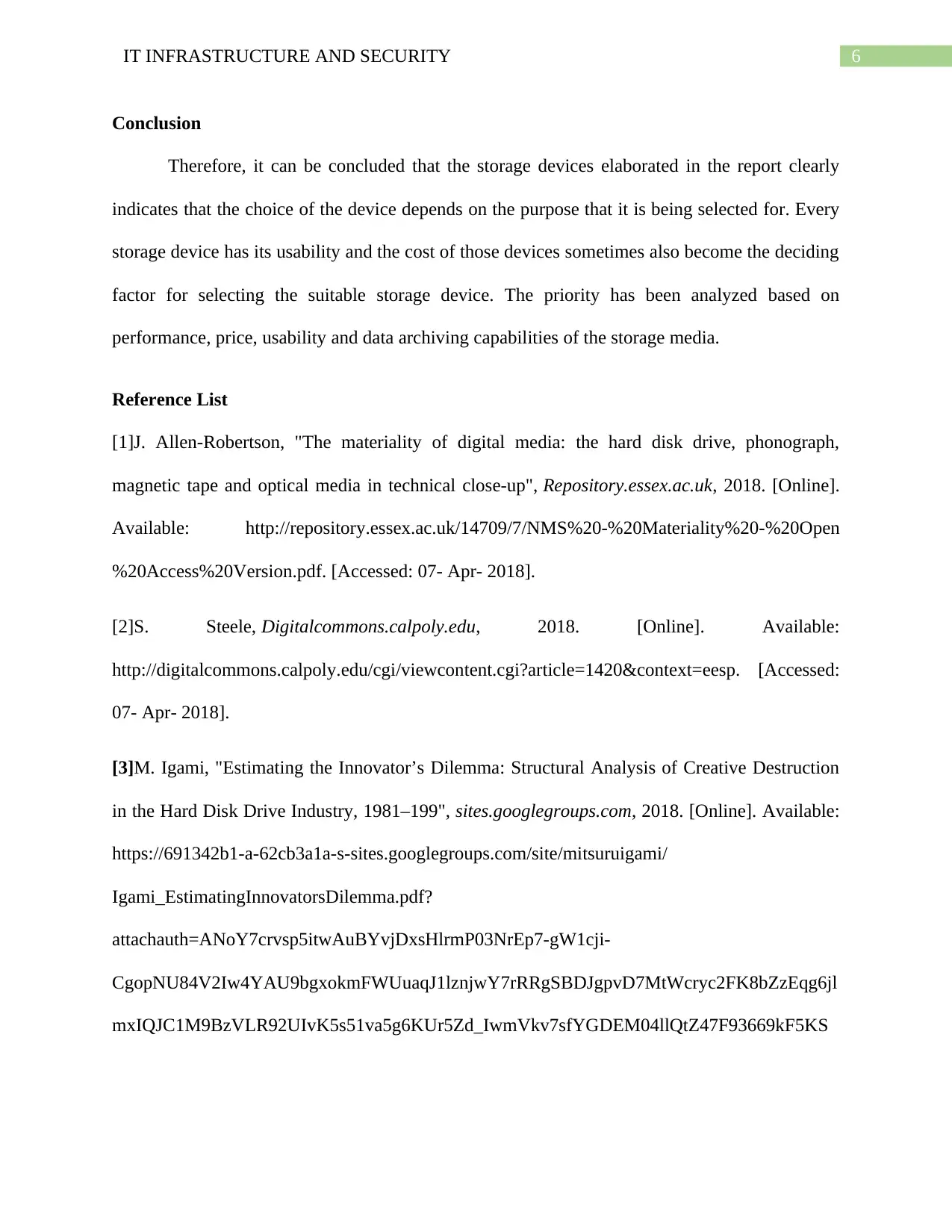
6IT INFRASTRUCTURE AND SECURITY
Conclusion
Therefore, it can be concluded that the storage devices elaborated in the report clearly
indicates that the choice of the device depends on the purpose that it is being selected for. Every
storage device has its usability and the cost of those devices sometimes also become the deciding
factor for selecting the suitable storage device. The priority has been analyzed based on
performance, price, usability and data archiving capabilities of the storage media.
Reference List
[1]J. Allen-Robertson, "The materiality of digital media: the hard disk drive, phonograph,
magnetic tape and optical media in technical close-up", Repository.essex.ac.uk, 2018. [Online].
Available: http://repository.essex.ac.uk/14709/7/NMS%20-%20Materiality%20-%20Open
%20Access%20Version.pdf. [Accessed: 07- Apr- 2018].
[2]S. Steele, Digitalcommons.calpoly.edu, 2018. [Online]. Available:
http://digitalcommons.calpoly.edu/cgi/viewcontent.cgi?article=1420&context=eesp. [Accessed:
07- Apr- 2018].
[3]M. Igami, "Estimating the Innovator’s Dilemma: Structural Analysis of Creative Destruction
in the Hard Disk Drive Industry, 1981–199", sites.googlegroups.com, 2018. [Online]. Available:
https://691342b1-a-62cb3a1a-s-sites.googlegroups.com/site/mitsuruigami/
Igami_EstimatingInnovatorsDilemma.pdf?
attachauth=ANoY7crvsp5itwAuBYvjDxsHlrmP03NrEp7-gW1cji-
CgopNU84V2Iw4YAU9bgxokmFWUuaqJ1lznjwY7rRRgSBDJgpvD7MtWcryc2FK8bZzEqg6jl
mxIQJC1M9BzVLR92UIvK5s51va5g6KUr5Zd_IwmVkv7sfYGDEM04llQtZ47F93669kF5KS
Conclusion
Therefore, it can be concluded that the storage devices elaborated in the report clearly
indicates that the choice of the device depends on the purpose that it is being selected for. Every
storage device has its usability and the cost of those devices sometimes also become the deciding
factor for selecting the suitable storage device. The priority has been analyzed based on
performance, price, usability and data archiving capabilities of the storage media.
Reference List
[1]J. Allen-Robertson, "The materiality of digital media: the hard disk drive, phonograph,
magnetic tape and optical media in technical close-up", Repository.essex.ac.uk, 2018. [Online].
Available: http://repository.essex.ac.uk/14709/7/NMS%20-%20Materiality%20-%20Open
%20Access%20Version.pdf. [Accessed: 07- Apr- 2018].
[2]S. Steele, Digitalcommons.calpoly.edu, 2018. [Online]. Available:
http://digitalcommons.calpoly.edu/cgi/viewcontent.cgi?article=1420&context=eesp. [Accessed:
07- Apr- 2018].
[3]M. Igami, "Estimating the Innovator’s Dilemma: Structural Analysis of Creative Destruction
in the Hard Disk Drive Industry, 1981–199", sites.googlegroups.com, 2018. [Online]. Available:
https://691342b1-a-62cb3a1a-s-sites.googlegroups.com/site/mitsuruigami/
Igami_EstimatingInnovatorsDilemma.pdf?
attachauth=ANoY7crvsp5itwAuBYvjDxsHlrmP03NrEp7-gW1cji-
CgopNU84V2Iw4YAU9bgxokmFWUuaqJ1lznjwY7rRRgSBDJgpvD7MtWcryc2FK8bZzEqg6jl
mxIQJC1M9BzVLR92UIvK5s51va5g6KUr5Zd_IwmVkv7sfYGDEM04llQtZ47F93669kF5KS
Paraphrase This Document
Need a fresh take? Get an instant paraphrase of this document with our AI Paraphraser
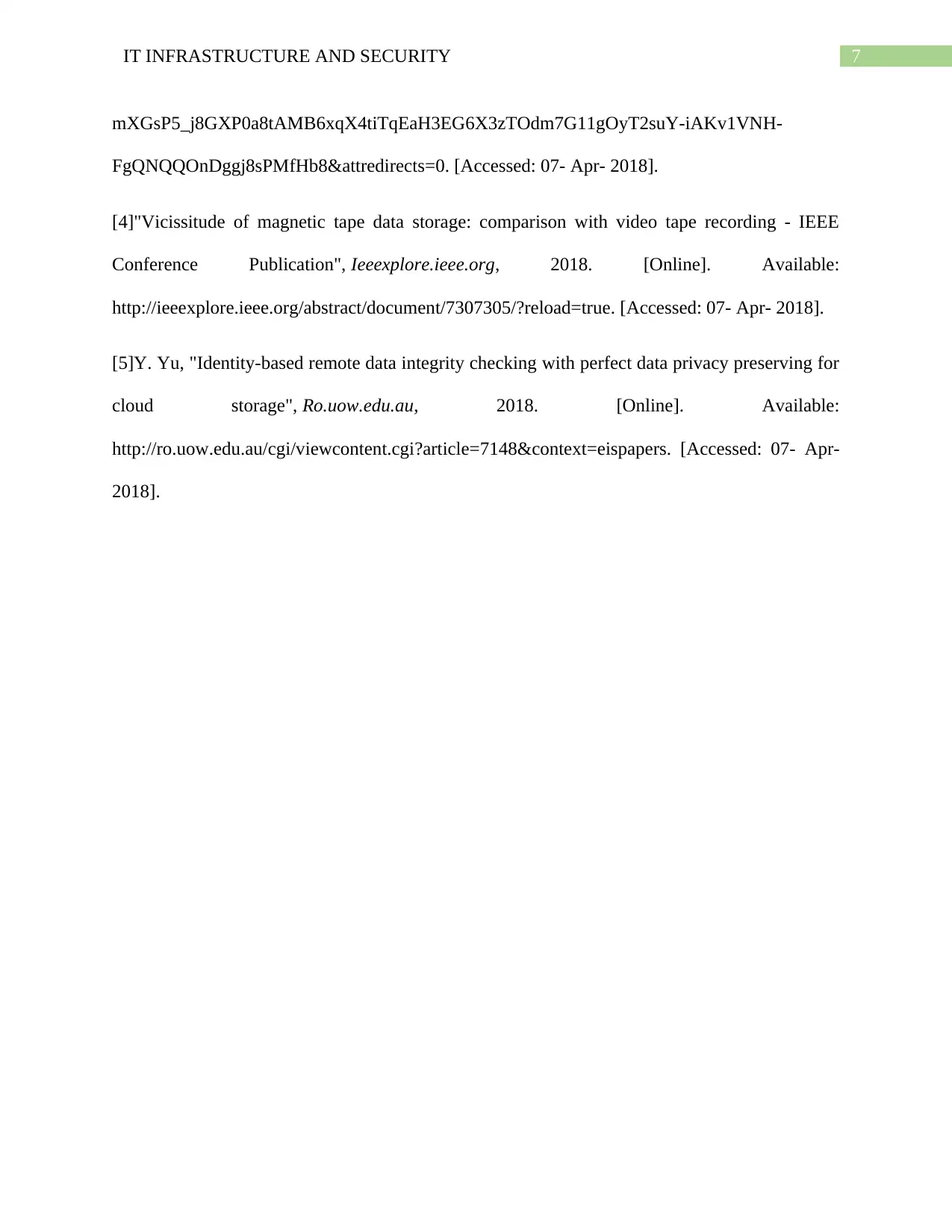
7IT INFRASTRUCTURE AND SECURITY
mXGsP5_j8GXP0a8tAMB6xqX4tiTqEaH3EG6X3zTOdm7G11gOyT2suY-iAKv1VNH-
FgQNQQOnDggj8sPMfHb8&attredirects=0. [Accessed: 07- Apr- 2018].
[4]"Vicissitude of magnetic tape data storage: comparison with video tape recording - IEEE
Conference Publication", Ieeexplore.ieee.org, 2018. [Online]. Available:
http://ieeexplore.ieee.org/abstract/document/7307305/?reload=true. [Accessed: 07- Apr- 2018].
[5]Y. Yu, "Identity-based remote data integrity checking with perfect data privacy preserving for
cloud storage", Ro.uow.edu.au, 2018. [Online]. Available:
http://ro.uow.edu.au/cgi/viewcontent.cgi?article=7148&context=eispapers. [Accessed: 07- Apr-
2018].
mXGsP5_j8GXP0a8tAMB6xqX4tiTqEaH3EG6X3zTOdm7G11gOyT2suY-iAKv1VNH-
FgQNQQOnDggj8sPMfHb8&attredirects=0. [Accessed: 07- Apr- 2018].
[4]"Vicissitude of magnetic tape data storage: comparison with video tape recording - IEEE
Conference Publication", Ieeexplore.ieee.org, 2018. [Online]. Available:
http://ieeexplore.ieee.org/abstract/document/7307305/?reload=true. [Accessed: 07- Apr- 2018].
[5]Y. Yu, "Identity-based remote data integrity checking with perfect data privacy preserving for
cloud storage", Ro.uow.edu.au, 2018. [Online]. Available:
http://ro.uow.edu.au/cgi/viewcontent.cgi?article=7148&context=eispapers. [Accessed: 07- Apr-
2018].
1 out of 8
Related Documents
Your All-in-One AI-Powered Toolkit for Academic Success.
+13062052269
info@desklib.com
Available 24*7 on WhatsApp / Email
![[object Object]](/_next/static/media/star-bottom.7253800d.svg)
Unlock your academic potential
© 2024 | Zucol Services PVT LTD | All rights reserved.





